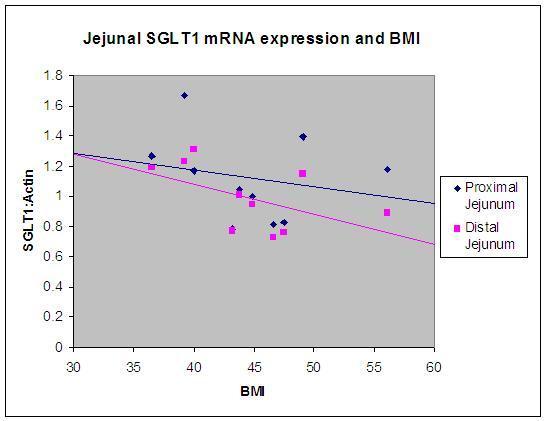Topographic Expression of Intestinal Sugar Sensors and Transporters in Obesity: Tissue Analysis of Patients Undergoing Gastric Bypass Surgery
Hina Y. Bhutta*1,2, David B. Rhoads3,2, Stanley W. Ashley1,2, Ali Tavakkolizadeh1,2
1General Surgery, Brigham and Women's Hospital, Boston, MA; 2Harvard Medical School, Boston, MA; 3Pediatric Endocrinology, Massachusetts General Hospital, Boston, MA
Introduction
Obesity and associated type 2 diabetes mellitus (T2DM) have reached epidemic proportions around the world. Roux-en-Y Gastric Bypass surgery (RYGB) remains the gold standard therapy for obesity that also leads to a rapid resolution of T2DM. Our previous rodent studies have suggested a role for SGLT1 in mediating these metabolic benefits. These experiments had shown that RYGB alters SGLT1 function by blunting intestinal taste receptor stimulation, leading to decreased SGLT1 function. There is a paucity of data on intestinal expression of these transporters in humans. We aimed to investigate the topography of intestinal expression of glucose transporters along with sweet taste receptors amongst an obese cohort of patients undergoing RYGB.
Methods
10 normoglycemic patients (4 male, 6 female) undergoing RYGB for obesity were enrolled in this study over a 2 month period (mean age= 51 years, mean BMI= 44.7). Whilst undergoing RYGB surgery, jejunal biopsies were taken 40cm (proximal) and 140cm (distal) from the ligament of treitz. Following RNA extraction from the tissues and reverse transcription, mRNA expression of SGLT1, GLUT2, and T1R2 (a protein involved in the sweet taste receptor heterodimer) was measured using qRT-PCR. Statistical analysis was performed using paired students’ t-test and Pearson’s correlation coefficient.
Results
Intestinal expression of SGLT1 was higher in the proximal jejunum than in the distal jejunum (p=0.05) (Figure 1). There was also a trend towards an inverse correlation between SGLT1 expression in distal jejunum and BMI (r= 0.29) (Figure 2). GLUT2 mRNA had a higher expression pattern in the proximal jejunum compared to distal, although this was not significant (p=0.16). There was no association between GLUT2 levels and BMI. There was no topographic difference or correlation with BMI in T1R2 expression.
Conclusion
Transporters and sensors that we believe are involved in achieving the metabolic benefit of RYGB are present in human tissue and show topographic variation within the jejunum. Importantly, the glucose transporter SGLT1, which accounts for almost all active transport of glucose across the apical border of the intestine, shows an inverse correlation with BMI in the obese range. Further work is needed to elucidate the role of this transporter in the etiology of obesity.
Fig 1. Topographic mRNA expression of SGLT1 and T1R2 in the jejunum. Proximal jejunum compared to distal jejunum.*P=0.05
Fig 2. Correlation between jejunal SGLT1 mRNA expression and BMI. R=0.29 for distal jejunum
Back to 2011 Program



